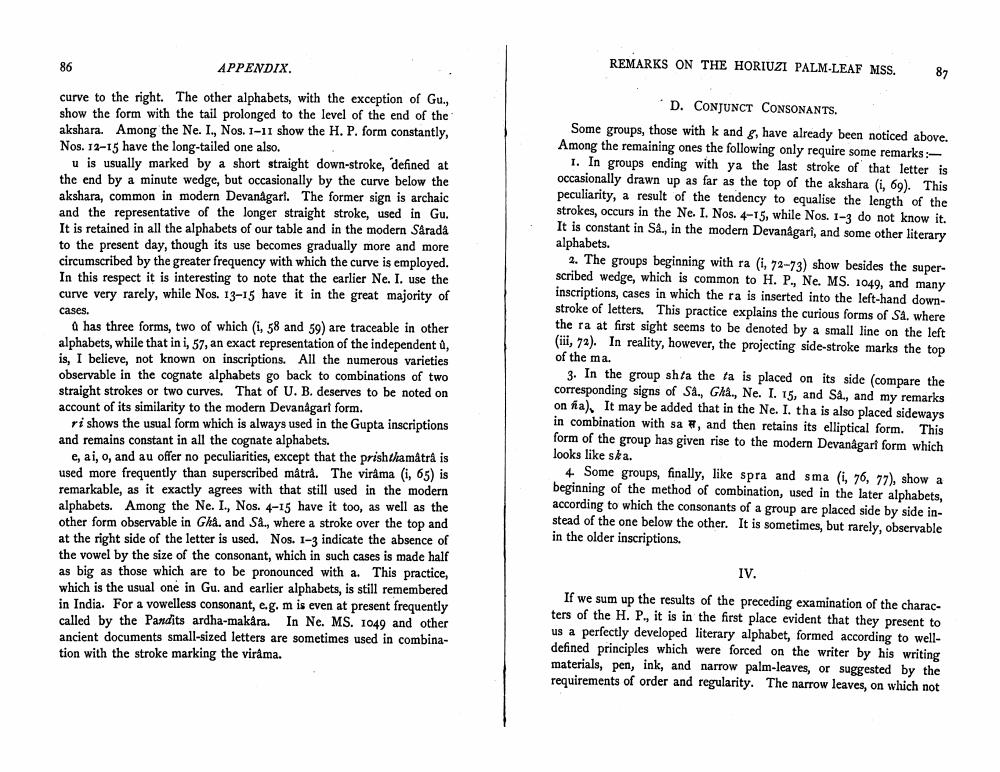________________
86
APPENDIX.
curve to the right. The other alphabets, with the exception of Gu., show the form with the tail prolonged to the level of the end of the akshara. Among the Ne. I., Nos. 1-11 show the H. P. form constantly, Nos. 12-15 have the long-tailed one also.
u is usually marked by a short straight down-stroke, 'defined at the end by a minute wedge, but occasionally by the curve below the akshara, common in modern Devanagari. The former sign is archaic and the representative of the longer straight stroke, used in Gu. It is retained in all the alphabets of our table and in the modern Sâradâ to the present day, though its use becomes gradually more and more circumscribed by the greater frequency with which the curve is employed. In this respect it is interesting to note that the earlier Ne. I. use the curve very rarely, while Nos. 13-15 have it in the great majority of
cases.
û has three forms, two of which (i, 58 and 59) are traceable in other alphabets, while that in i, 57, an exact representation of the independent û, is, I believe, not known on inscriptions. All the numerous varieties observable in the cognate alphabets go back to combinations of two straight strokes or two curves. That of U. B. deserves to be noted on account of its similarity to the modern Devanagari form.
ri shows the usual form which is always used in the Gupta inscriptions and remains constant in all the cognate alphabets.
e, ai, o, and au offer no peculiarities, except that the prishthamåtrå is used more frequently than superscribed mâtrå. The virâma (i, 65) is remarkable, as it exactly agrees with that still used in the modern alphabets. Among the Ne. I., Nos. 4-15 have it too, as well as the other form observable in Ghâ. and Så., where a stroke over the top and at the right side of the letter is used. Nos. 1-3 indicate the absence of the vowel by the size of the consonant, which in such cases is made half as big as those which are to be pronounced with a. This practice, which is the usual one in Gu. and earlier alphabets, is still remembered in India. For a vowelless consonant, e.g. m is even at present frequently called by the Pandits ardha-makára. In Ne. MS. 1049 and other ancient documents small-sized letters are sometimes used in combination with the stroke marking the virâma.
REMARKS ON THE HORIUZI PALM-LEAF MSS.
87
D. CONJUNCT CONSONANTS.
Some groups, those with k and g, have already been noticed above. Among the remaining ones the following only require some remarks:
1. In groups ending with ya the last stroke of that letter is occasionally drawn up as far as the top of the akshara (i, 69). This peculiarity, a result of the tendency to equalise the length of the strokes, occurs in the Ne. I. Nos. 4-15, while Nos. 1-3 do not know it. It is constant in Sâ., in the modern Devanagari, and some other literary alphabets.
2. The groups beginning with ra (i, 72-73) show besides the superscribed wedge, which is common to H. P., Ne. MS. 1049, and many inscriptions, cases in which the ra is inserted into the left-hand downstroke of letters. This practice explains the curious forms of Så. where the ra at first sight seems to be denoted by a small line on the left (iii, 72). In reality, however, the projecting side-stroke marks the top of the ma.
3. In the group shta the ta is placed on its side (compare the corresponding signs of Sa., Ghâ., Ne. I. 15, and Sâ., and my remarks on fia), It may be added that in the Ne. I. tha is also placed sideways in combination with sa , and then retains its elliptical form. This form of the group has given rise to the modern Devanagari form which looks like ska.
4 Some groups, finally, like spra and sma (i, 76, 77), show a beginning of the method of combination, used in the later alphabets, according to which the consonants of a group are placed side by side instead of the one below the other. It is sometimes, but rarely, observable in the older inscriptions.
IV.
If we sum up the results of the preceding examination of the characters of the H. P., it is in the first place evident that they present to us a perfectly developed literary alphabet, formed according to welldefined principles which were forced on the writer by his writing materials, pen, ink, and narrow palm-leaves, or suggested by the requirements of order and regularity. The narrow leaves, on which not




